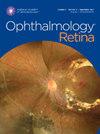Exploring Clinical Features of Polypoidal Choroidal Vasculopathy in Black Patients
IF 5.7
Q1 OPHTHALMOLOGY
引用次数: 0
Abstract
Objective
This study aimed to evaluate the clinical and angiographic presentation of polypoidal choroidal vasculopathy (PCV) in a large cohort of Black patients.
Design
We conducted a descriptive cross-sectional analysis.
Participants
Out of 283 patients followed for PCV in our department, 167 cases were confirmed by indocyanine green angiography (ICGA). The remaining patients lacked ICGA imaging. Among the 167 confirmed cases, 57 patients were excluded due to significant ophthalmological comorbidities, leaving 160 affected eyes in 110 patients for analysis.
Methods
We reviewed the most recent retinophotography, OCT, fluorescein, and ICGA images in our database. All analyzed patients were followed and underwent their examinations at the University Hospital Center of Martinique, a referral center in Fort de France primarily serving a Black population. An exploratory analysis of choroidal features was made in those who underwent enhanced depth imaging spectral-domain OCT. In parallel, a literature review on PCV was performed to contextualize our findings.
Main Outcome Measures
We measured visual acuity, sex ratio, patient age, characteristics of exudative phenomena, polyp location, and PCV type according to Kawamura classification.
Results
Most patients were women (62.7%), with an average age of 72.2 ± 10.1 years. Among the 160 eyes, 81.9% exhibited idiopathic type 2 PCV and 52.4% showed peripapillary polyp distribution. The mean visual acuity was 0.29 ± 0.3 logarithm of the minimum angle of resolution. Soft drusen were present in 15% of eyes, and 44.5% of patients had bilateral involvement. Black patients seem to have distinctive PCV characteristics compared with other ethnic groups, with a low incidence of macular polyps (23.1%), a high incidence of peripapillary polyps (52.4%), and high incidence of bilateral involvement (42.8%).
Conclusions
This is the largest series of Afro-descendant patients with PCV ever described in the literature. Polypoidal choroidal vasculopathy in our population is primarily type 2 PCV according to Kawamura's classification, predominantly affecting women, often bilateral, with a preferentially extramacular location of the polyps. These observations may be explained by the fact that PCV in these patients is not the result of neovascularization but rather linked to a generalized disease of the choroid, such as pachychoroid.
Financial Disclosure(s)
The authors have no proprietary or commercial interest in any materials discussed in this article.
探讨黑人患者息肉样脉络膜血管病变的临床特征:一项横断面研究和全面回顾。
目的:本研究旨在评估大量黑人患者的息肉样脉络膜血管病变(PCV)的临床和血管造影表现。设计:我们进行了描述性横断面分析。对象:我科随访PCV患者283例,ICG确诊167例。其余患者缺乏ICG成像。在167例确诊病例中,有57例患者因有明显的眼科合并症而被排除,剩下110例患者的160只受影响的眼睛进行分析。方法:我们回顾了我们数据库中最新的视网膜摄影,光学相干断层扫描(OCT),荧光素和吲哚菁绿血管造影(ICGA)图像。所有分析的患者都被跟踪并在马提尼克大学医院中心接受了检查,这是一个位于法兰西堡的转诊中心,主要为黑人服务。我们对接受深度成像光谱域OCT (EDI-SD-OCT)的患者进行了脉络膜特征的探索性分析。同时,我们对PCV进行了文献回顾,将我们的研究结果置于背景中。主要观察指标:根据Kawamura分类测定视力、性别比、患者年龄、渗出现象特征、息肉位置、PCV类型。结果:患者以女性居多(62.7%),平均年龄72.2±10.1岁。160只眼中,81.9%表现为特发性2型PCV, 52.4%表现为乳头周围息肉分布。平均视力为0.29±0.3 LogMAR。15%的患者有眼软囊肿,44.5%的患者有双侧受累。与其他种族相比,黑人患者似乎具有明显的PCV特征,黄斑息肉发生率低(23.1%),乳头周围息肉发生率高(52.4%),双侧受累发生率高(42.8%)。结论和相关性:这是文献中报道的最大的非洲后裔息肉样脉络膜血管病变(PCV)患者系列。根据Kawamura的分类,我们人群中的PCV主要是2型PCV,主要影响女性,通常是双侧,息肉优先发生在黄斑外。这些观察结果可能是由于这些患者的PCV不是新生血管形成的结果,而是与脉络膜的全身性疾病(如厚脉络膜)有关。
本文章由计算机程序翻译,如有差异,请以英文原文为准。
求助全文
约1分钟内获得全文
求助全文

 求助内容:
求助内容: 应助结果提醒方式:
应助结果提醒方式:


